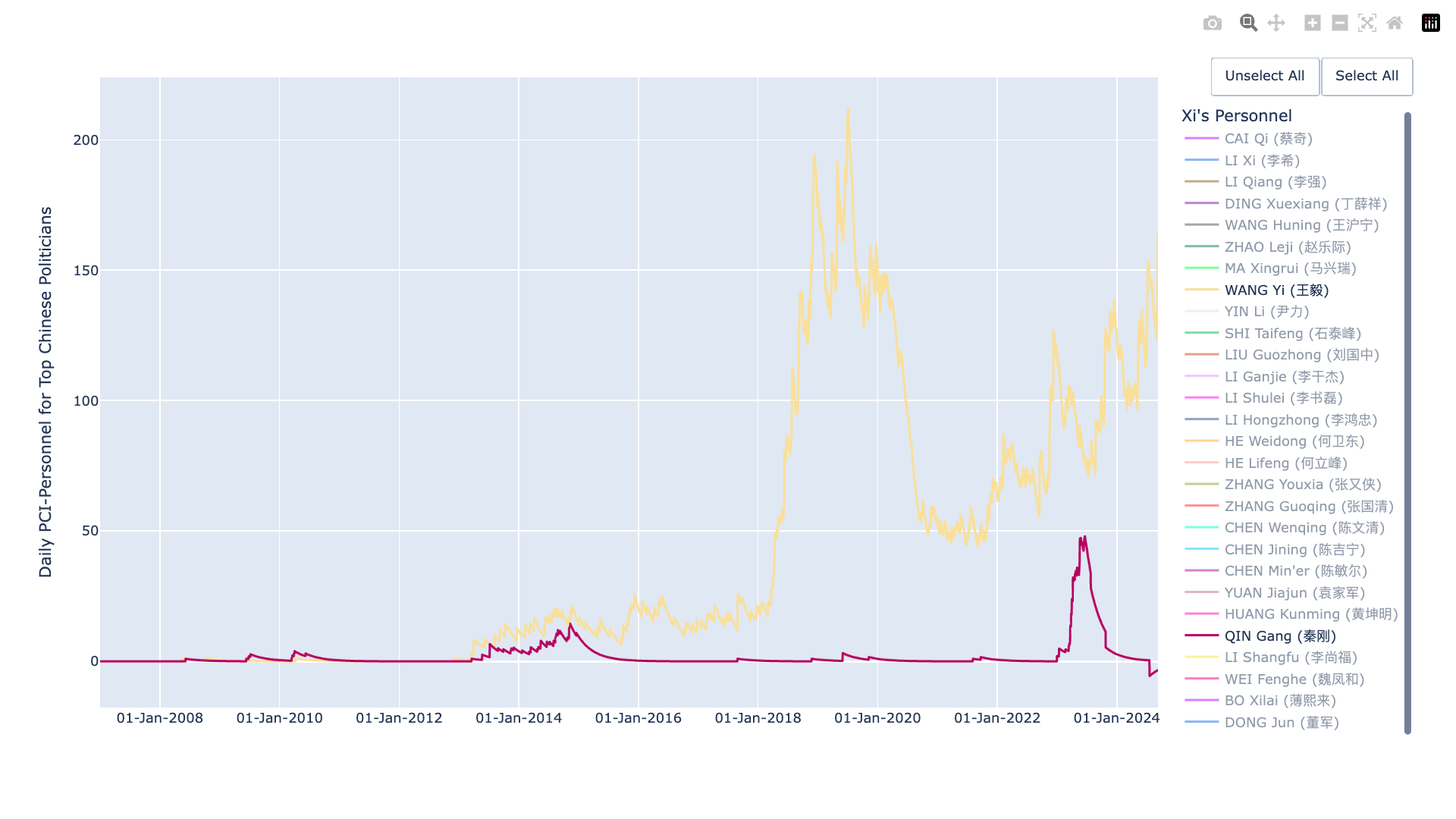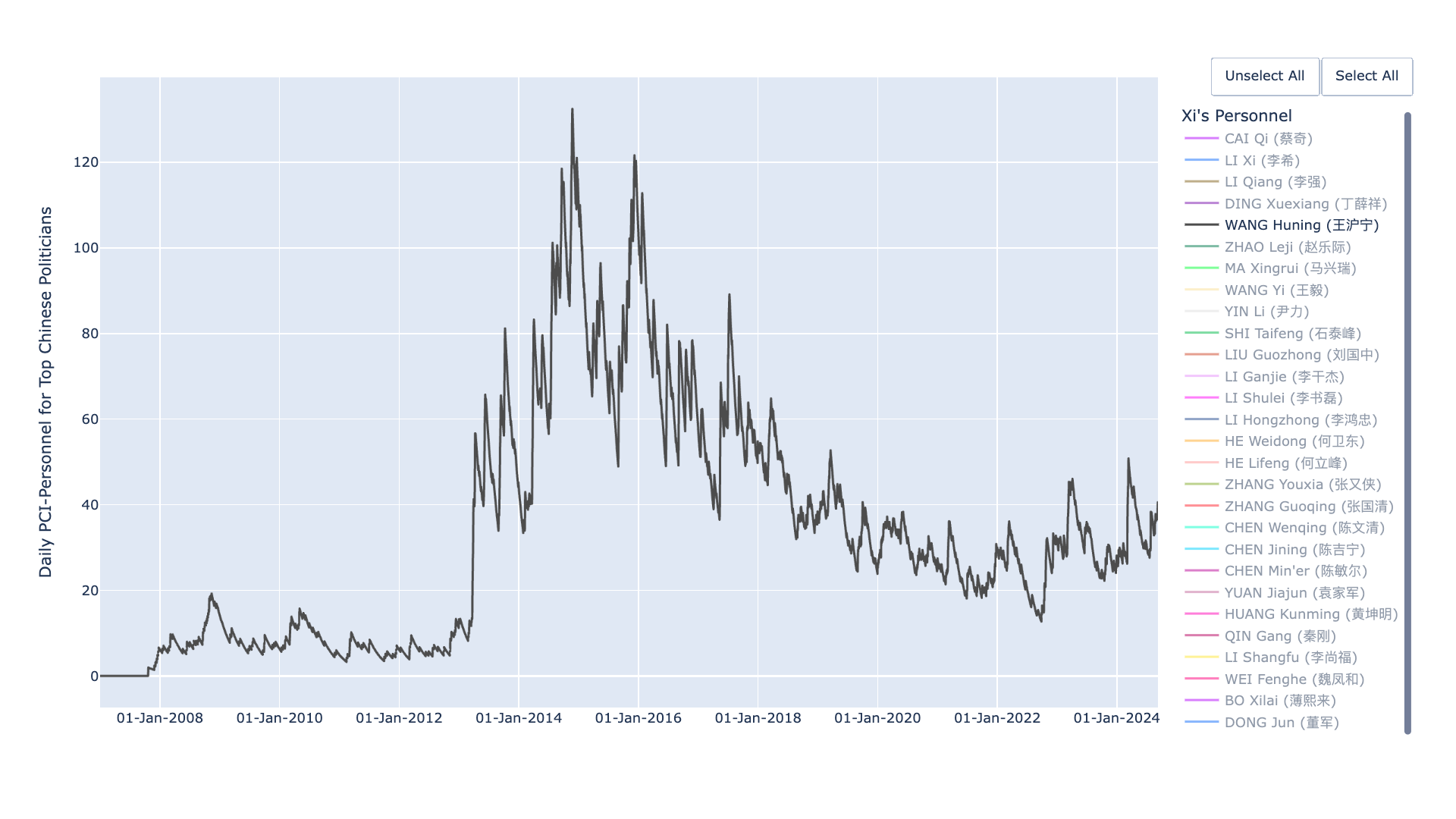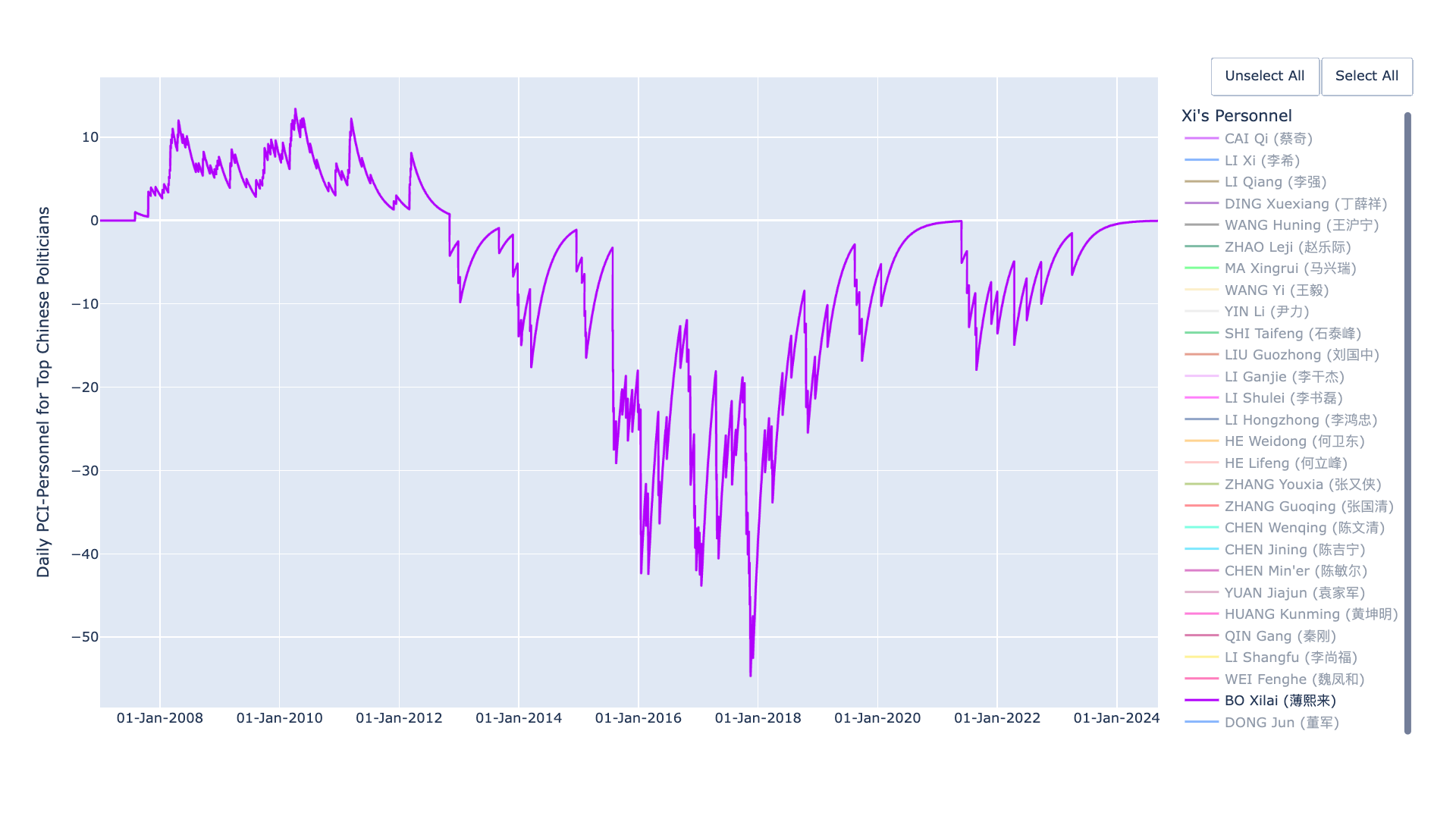The PCI-Personnel is an algorithm for tracking the prominence of
different personnel around a political leader. In a first use case, we
develop the PCI-Personnel for Chinese politicians around Chinese
President Xi Jinping. Figure 1 below plots the indices for 28 top
politicians in China from 2007 to the present. The value of an index
measures how positive a politician’s public image is as perceived by the
People’s Daily, the most prominent official newspapers of the
Chinese Community Party.
Figure 1. PCI-Personnel for Top Chinese Politicians Around
President Xi Jinping
For technical details about this algorithm, check out the source code and stay tune for our
upcoming research paper on the subject.
Introduction
Chinese politics remains one of the world’s most important yet least
understood. One aspect of that mystery has been the often unexpected and
dramatic rise and fall of top officials. When Chinese President Xi
Jinping assumed a third five-year term in 2022, he made surprising
choices like Li Qiang and Cai Qi for the Politburo Standing Committee. A
year later, Xi purged his Foreign Minister Qin Gang, Defense chief Li
Shangfu and several top commanders of the People’s Liberation Army’s
Rocket Force—all within a few months. Previous Chinese leaders are known
to have done the same rather frequently.
In this project, we develop an automated tracker, the Policy Change
Index for Personnel (PCI-Personnel), for the rise of fall of key Chinese
politicians. The algorithm uses large language models (LLMs) to quantify
each politician’s relationship with Xi, as reflected in the Chinese
Communist Party’s official newspaper, the People’s Daily. The
PCI-Personnel is a daily indicator that covers the period from
2007—approximately five years before Xi took the helm of the CCP—to the
present. Initial results suggest that the index’s value tracks, and in
some cases seems to be a leading indicator of, the prominence of top
Chinese officials.
The effectiveness of this prominence tracker rests on the nature of
China’s propaganda system: The CCP uses mass media to align public
opinion with the policies it intends to implement, so that the people
are more likely to be onboard with the policy rollout. The same is true
for promoting or demoting party officials, who are in turn tasked to
carry out policies. Therefore, by measuring those politicians’ public
image in the party’s propaganda, the index tracks and could even predict
the officials’ political fortune—or the lack thereof.
Methodology
The PCI-Personnel algorithm consists of the following five steps:
Data extraction: It takes input data from the full text of the
People’s Daily.
Data preparation: We first compile a list of persons of interest
(POIs), which in the current version includes 28 top Chinese politicians
formerly or currently serving in the CCP’s Central Committee. For each
POI, the algorithm then selects news articles that involve both the POI
and Xi (e.g., when they appear at a same public event).
Data analysis: We employ LLMs to assign a score on a scale of -5
to +5 for the relationship between the POI and Xi as perceived by the
newspaper. For each POI, the LLM analysis is implemented at the article
level; that is, the relationship between any POI and Xi could fluctuate
from article to article, or from time to time.
Modelling: For each POI, we aggregate the article-level
relationship scores into a (POI-level) index over time. Specifically,
the index for each POI starts with 0 on January 1, 2001. On each day, we
aggregate the scores across all relevant articles and add the sum to the
index. However, if a POI doesn’t receive coverage on any day, their
index value decays by 1% compared to the day before. In other words,
without any further converge, an index, positive or negative, would
converge to 0 in the long run. The idea of the decay assumption is that,
for a politician who is highly placed and used to being positively and
regularly covered by the party mouthpiece, no press essentially means
bad press. On the other hand, when a politician previously covered
negatively starts to retreat from the spotlight, it might suggest an
improvement of status.
Visualization: We plot and deploy the numerical indices for all
POIs and continue to update the results as new data continues to flow
in.
We have released the source code of the PCI-Personnel project on
GitHub, which can be found here.
Main Results
While Figure 1 allows a user to select/unselect POIs to be plotted,
we discuss the results for a few high-profile cases and demonstrate that
the index is consistent with and in some cases leading the POI’s
political fortune.
Qin Gang had a meteoric rise in early 2023 after he was promoted from
the Ambassador to the United States to the Minister of Foreign Affairs,
and so did his PCI-Personnel index as shown in Figure 2. However, Qin’s
“stock” in the index started to trend downwards in late June 2023, weeks
before rumors about his disappearance and subsequent ousting surfaced in
late July.
Wang Yi, Qin’s predecessor, became the foreign minister in 2013.
However, his PCI-Personnel index did not take off until early 2018,
shortly before he was named a state councilor, a high-ranking post in
China’s State Council, in March 2018. While his index declined
temporarily during 2020, likely due to the COVID-19 pandemic that put
China’s foreign affairs on a pause, it continued to climb from 2021 to
the present. The trend is consistent with his increasing prominence
around Xi, including being promoted to the Politburo in 2022 and
reinstated as the foreign minister in 2023 after Qin’s downfall.
Figure 2. PCI-Personnel for Qin Gang and Wang Yi
Note: The figure was created on September 9, 2024.
Wang Huning, by now a well-known confidant and favored “political
theorist” of Xi, is another case where the PCI-Personnel index timely
captured his rise. A long-time protégé of the Chinese President, Wang
started to assume important posts in early 2014, including being
appointed as the inaugural director of the CCP’s Central Commission for
Deepening Reform. But his PCI-Personnel index took off prior to that in
March 2013 (see Figure 3), when Xi took complete charge over the party
and the country.
Figure 3. PCI-Personnel for Wang Huning
Note: The figure was created on September 9, 2024.
Finally, the rise and fall of Bo Xilai, the former politician who
lost the power struggle against Xi in 2012, is marked in the
PCI-Personnel as well. The index for Bo was above the water when he was
the party head of Chongqing. However, it drastically dropped to negative
starting from 2012 as Bo came under investigation for the Wang Lijun
incident, was put on trial in 2013, and jailed later that year. The
index continued to trend down for a few more years before bouncing back
to 0 due to the model’s decay mechanism.
Figure 4. PCI-Personnel for Bo Xilai
Note: The figure was created on September 9, 2024.
Future Developments
A few improvements are in the roadmap of the algorithm’s
development:
Improve the scope and accuracy of the LLM analysis. We will
continue to expand the list of POIs the algorithm tracks. We will also
fine-tune the LLM to home in on People’s Daily articles that
are more substantively related to the relationship between a POI and Xi,
as opposed to merely mentioning them together in passing, or even not
mentioning them within the same context.
Account for the index’s current bias against military officials.
Because the People’s Daily is a general-interest newspaper,
military content—hence the coverage of military officials—carries a
relatively smaller weight. This imbalance could be addressed by
including other CCP publications that are more military-relevant, such
as the PLA Daily.
Improve the model from a tracker to a predictor. While it’s
reassuring that the index generally tracks a politician’s prominence, it
would be of a much higher value if the index is a leading indicator of
the (eventual) political fortune. We have demonstrated this predictive
potential in a few examples above. Next, we will seek to have that
predictive capability more generally across different
politicians.
Acknowledgement
This project is a collaboration between PCI and Gear Factory, a
company specialized in deploying artificial intelligence solutions.


